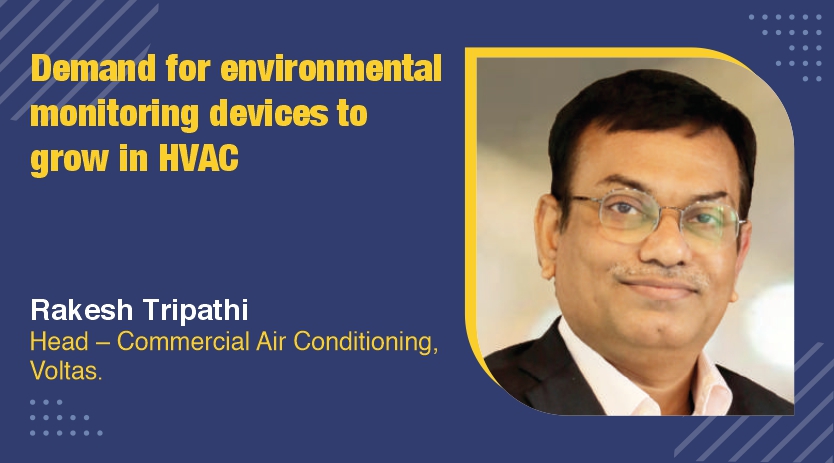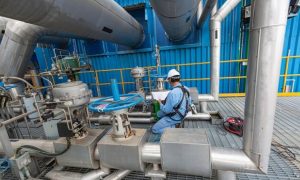Sharing his views, Rakesh Tripathi, Head – of Commercial Air Conditioning, Voltas, states it is anticipated that HVAC equipment will soon be equipped with features to capture temperature and humidity, enabling the integration of machine learning and AI algorithms.
Please talk about economically viable AC equipment for large public spaces.
Central air conditioning systems are the most appropriate choice for cooling public areas like commercial complexes, shopping malls, office buildings, airports, and sports stadiums due to their efficient cooling capabilities and ability to handle large crowds. To enhance energy efficiency and reduce operational costs, inverter technology and equipment with variable load offerings are utilised to maximise savings.
Voltas is committed to delivering economically viable air conditioning solutions for public spaces by offering various products, including chiller package units, VRFs, packaged systems, and ducted systems. Our approach considers initial cost, energy efficiency, and maintenance requirements. Our team of experts works closely with customers to determine the most suitable equipment for their specific needs, ensuring optimal comfort or process cooling depending on the application and cost-effectiveness.
How do you evaluate the sensor market for environmental temperature and humidity monitoring?
As IoT and AI technologies continue to advance, there is a growing need to collect extensive data on the operation of HVAC equipment and its surrounding environment. Therefore, it is anticipated that HVAC equipment will soon be equipped with features to capture temperature and humidity, enabling the integration of machine learning and AI algorithms. Sensors will be crucial in this process, facilitating prediction and monitoring of the environment. The demand for environmental monitoring devices is expected to experience significant growth shortly.
What recent advancements have occurred in cost-effective HVAC systems for supermarkets?
In recent years, there have been notable advancements in cost-effective HVAC systems for supermarkets. As a company, Voltas remains up-to-date with these developments and provides innovative solutions to meet the evolving requirements of the supermarket industry. One significant advancement is the integration of energy-efficient technologies into HVAC systems. Supermarkets have high cooling and refrigeration needs, and it is crucial to optimise energy usage to reduce operational costs. Technologies like variable refrigerant flow (VRF) systems, demand-controlled ventilation, and energy recovery systems are now being used to improve energy efficiency and minimise energy consumption.
Another important development is incorporating advanced controls and automation in HVAC systems for supermarkets. Smart controls, building management systems, and integration with the Internet of Things (IoT) allow for centralised monitoring and control of various HVAC components. This enhances system performance, enables remote diagnostics, and facilitates proactive maintenance, reducing downtime and improving operational efficiency.
Moreover, the emergence of eco-friendly refrigerants has positively impacted cost-effective HVAC systems for supermarkets. Environmentally friendly refrigerants with low global warming potential (GWP) and zero ozone depletion potential (ODP) are increasingly being adopted. This ensures compliance with environmental regulations while minimising long-term operating costs.
Voltas actively embraces these developments and provides comprehensive HVAC solutions tailored to the specific needs of supermarkets. With expertise in energy-efficient technologies, advanced controls, and sustainable refrigerants, Voltas designs and implements cost-effective HVAC systems that deliver optimal performance, energy savings, and environmental sustainability.

How are IoT and new HVAC technologies impacting workforce training in the HVAC industry?
Voltas acknowledges the significant influence of IoT and new technologies on the HVAC sector, particularly regarding the training and development of the workforce. The integration of IoT in HVAC equipment has brought about a revolutionary change in how technicians operate and maintain these systems, resulting in an increased demand for specialised skills and knowledge. With the implementation of IoT-enabled HVAC equipment, technicians can remotely monitor and control systems, analyse data for performance optimisation and conduct predictive maintenance. As a result, training approaches have had to adapt to ensure technicians effectively utilise these advanced technologies.
At Voltas, we are dedicated to empowering our workforce and after-sales partners with the necessary expertise to leverage the potential of IoT and new technologies. We provide comprehensive, personalised programs and training for our employees and have identified specific organisational training such as technical and functional programs. Our training initiatives incorporate practical experience with IoT-enabled HVAC equipment through hands-on exercises and simulations. Additionally, our research and development and manufacturing teams are actively working to integrate smart technologies like IoT and AI into our products and services. By doing so, we can offer our customers cutting-edge solutions, allowing Voltas to maintain its leadership position in this fiercely competitive industry.
How predictive maintenance sensors for temperature monitoring of cooling equipment in commercial places are impacting the HVAC market?
Predictive maintenance sensors for temperature monitoring and malfunctioning of cooling equipment in commercial places have had a significant impact on the HVAC market. As a leading player in the industry, Voltas acknowledges these sensors’ transformative potential. Using predictive maintenance sensors enables commercial establishments to actively monitor the temperature and performance of their cooling equipment in real time. This proactive monitoring allows for the early identification of potential malfunctions and abnormalities, facilitating timely interventions and preventive measures. As a result, downtime is minimised, maintenance costs are reduced, and the efficiency of HVAC systems is optimised. Additionally, predictive maintenance sensors provide valuable insights into the overall condition of HVAC systems, facilitating better planning and resource allocation. With access to real-time data and automated alerts, facility managers can prioritise maintenance activities, optimise scheduling, and ensure uninterrupted comfort for occupants.
Cookie Consent
We use cookies to personalize your experience. By continuing to visit this website you agree to our Terms & Conditions, Privacy Policy and Cookie Policy.















